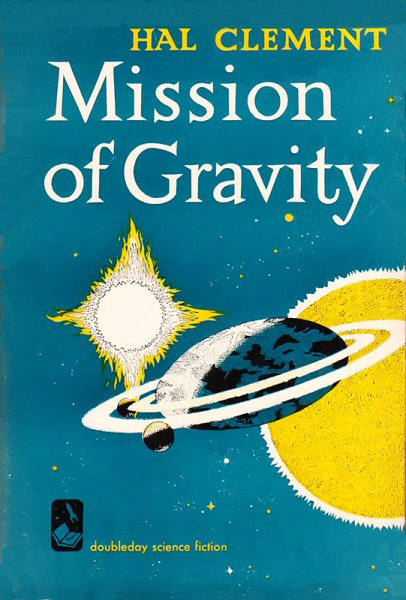"Mission of Gravity" by Hal Clement
Charles Lackland is far from home, holed up in an isolated outpost on the inhospitable planet Mesklin. Inhospitable to humans anyway, but not to the methane-based, centipede-like natives who are adapted to the enormously high and remarkably variable gravity, the fierce cold, and the extreme storms of this gigantic, disc-like planet. Lackland’s mission is to assist a crew of Mesklinite natives on a journey to recover mission data from an unmanned rocket that crashed near one of Mesklin’s poles. With a gravity 700 times that of Earth, the pole is a place no human can survive. But the natives, Captain Barlennan and his methane sea-faring crew of the Bree, can make the journey.
Barlennan is a trader and would-be explorer, living in a world whose technology seems to roughly correspond to 18th or early 19th century Earth technology – before the widespread use of machinery and electronics. Barlennan and his crew have agreed to help the humans retrieve the mission record from the crashed rocket. They are making an unprecedented trip to the pole, with the assistance of Lackland and a support staff of human physicists, engineers, biologists, and meterologists who are stationed on one of Mesklin’s moons. The trip turns out to be something like a Mesklinite voyage of the Beagle (the book could have been titled Voyage Of The Bree), a journey of discovery for both Lackland (who is only physically present for part of it) and Barlennan. The crew discovers exotic new sea creatures, massive geological formations, and natives on remote oceanic islands with curious technologies. Along the way, Barlennan and his crew are beneficiaries of the seemingly omnipotent, scientific problem-solving powers of the humans. After seeing the power that humans wield, Barlennan begins to develop an ulterior motive for this journey to find the human rocket.
Mission of Gravity is a quintessential work of hard science fiction. The physical attributes of the world of Mesklin are meticulously worked out, and even though some of Hal Clement’s science has turned out to be wrong, the thorough realization of Mesklin makes Mission of Gravity a landmark book in the genre. Hard science fiction thrives on exotic but physically realistic worlds; it also requires a cast of scientifically competent characters who try their skills against the world’s unique but soluble challenges. The heroes of classic hard sci-fi were designed to appeal to the nerdy readers of Astounding. Problems posed by the exotic world are solved by applying textbook physics familiar to any science-inclined high school student or college Freshman. Like the slide rule- bearing rocket scientists on the ground in Apollo 13, who walk Tom Hanks and Kevin Bacon through rapidly worked-out fixes, Lackland and his colleagues (one of whom actually does have a slide rule) use their engineering know-how to help the crew of the Bree overcome obstacles that threaten to defeat the mission. Over the course of the journey, Barlennan becomes envious of the humans’ power and technology, and believes that the secrets of science are purposely being kept from the Mesklinites. Lackland’s response is a recognition of science’s ideal of openness, but also its difficulty, a stoic attitude surely held by many Astounding readers:
“[These] things you would have to see in operation in other ways a long time before you could even begin to understand. That is not meant as an insult; what I say is almost as true for me, and I have grown up from childhood surrounded by and even using those forces. I do not understand them. I do not expect to understand them before I die; the science we have covers so much knowledge that no one man can even begin to learn all of it, and I must be satisfied with the field I do know – and perhaps add to it what little one man may in a lifetime.”
Mission of Gravity was serialized in Astounding in 1953, a time when sci-fi magazines were beginning to publish novel-length works that were not obvious fix-ups of short story series. In contrast to Kuttner’s Mutant, Simak’s City or Bradbury’s Martian Chronicles, works like The Demolished Man and The Long Tomorrow were unified, coherent works right from the first magazine installment. Mission of Gravity stands out as one of the earliest (maybe the earliest?) examples of hard sci-fi in fully coherent novel form, and its influence has been wide – Larry Niven’s Ringworld owes much to Mission of Gravity. (Mike White, The Finch and Pea)


Comments
Post a Comment